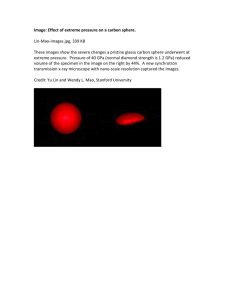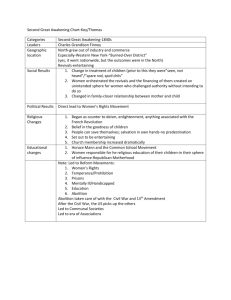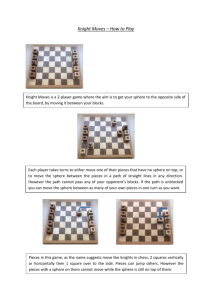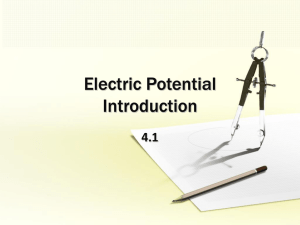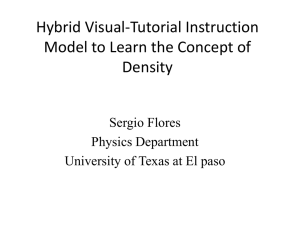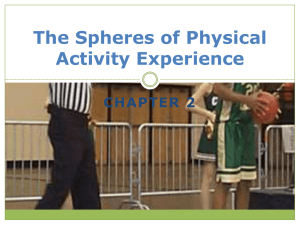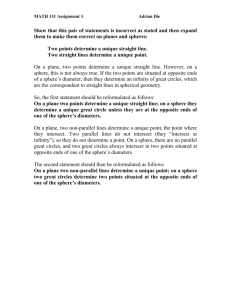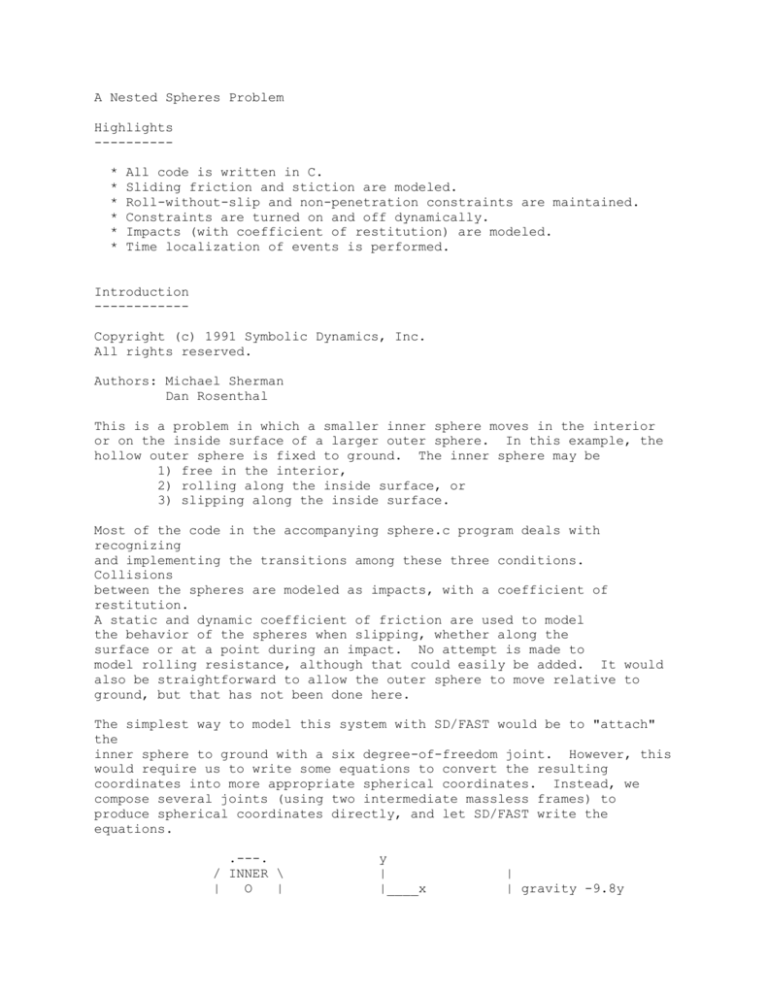
A Nested Spheres Problem
Highlights
---------*
*
*
*
*
*
All code is written in C.
Sliding friction and stiction are modeled.
Roll-without-slip and non-penetration constraints are maintained.
Constraints are turned on and off dynamically.
Impacts (with coefficient of restitution) are modeled.
Time localization of events is performed.
Introduction
-----------Copyright (c) 1991 Symbolic Dynamics, Inc.
All rights reserved.
Authors: Michael Sherman
Dan Rosenthal
This is a problem in which a smaller inner sphere moves in the interior
or on the inside surface of a larger outer sphere. In this example, the
hollow outer sphere is fixed to ground. The inner sphere may be
1) free in the interior,
2) rolling along the inside surface, or
3) slipping along the inside surface.
Most of the code in the accompanying sphere.c program deals with
recognizing
and implementing the transitions among these three conditions.
Collisions
between the spheres are modeled as impacts, with a coefficient of
restitution.
A static and dynamic coefficient of friction are used to model
the behavior of the spheres when slipping, whether along the
surface or at a point during an impact. No attempt is made to
model rolling resistance, although that could easily be added. It would
also be straightforward to allow the outer sphere to move relative to
ground, but that has not been done here.
The simplest way to model this system with SD/FAST would be to "attach"
the
inner sphere to ground with a six degree-of-freedom joint. However, this
would require us to write some equations to convert the resulting
coordinates into more appropriate spherical coordinates. Instead, we
compose several joints (using two intermediate massless frames) to
produce spherical coordinates directly, and let SD/FAST write the
equations.
.---.
/ INNER \
|
O
|
y
|
|____x
|
| gravity -9.8y
\
OUTER
/
`---'
/
V
z
The first massless frame, called LATLONG, is attached to the
point at the center of the outer sphere by a U-joint (two perpendicular
rotational degrees of freedom). The first coordinate is a rotation
about y (corresponding to longitude), the second is a rotation about x
(corresponding to latitude).
The other massless frame, called RADIUS, is attached to LATLONG by
a sliding joint in the RADIUS local y direction. This coordinate
represents the radial distance from the outer sphere center to the
inner sphere center. The inner sphere is attached to the RADIUS
frame by a ball joint at its center.
In the chosen reference configuration, where all the coordinates
are zero, the inner sphere is in the center of the outer sphere.
If the RADIUS coordinate is set to (R_OUTER-R_INNER) while all
other coordinates are left zero, the inner sphere touches the
outer sphere at the top. Note that this means the latitude is
considered zero at the top, 90 degrees at the equator, contrary to
common practice on maps where the equator is at zero latitude.
Three constraints are used in the model to (1) prevent the inner
sphere from penetrating the outer sphere, and (2) while the inner
sphere should be rolling, to prevent relative slipping between
the surfaces (in two directions). These constraints are turned on
and off as appropriate. The first is enabled only when the the
sphere is rolling or sliding along the inner surface, and the
other two constraints are enabled only while rolling.
The "non-penetration" constraint is implemented using SD/FAST's built-in
prescribed motion facility on the RADIUS sliding joint. Whenever
the spheres are supposed to maintain contact, the inner
sphere is simply presribed to be at the radius which just causes it
to contact the outer sphere. The sign of the resulting constraint
multiplier is monitored, and the prescribed motion constraint is turned
off if it would prevent the inner sphere from moving into the interior.
The "no-slip" constraints are implemented using SD/FAST's "user
constraint"
facility. These constraints are enabled only when the spheres are
supposed to be in rolling contact. When on, the resulting force (found
in the multipliers) is monitored and if its magnitude exceeds the
static coefficient of friction times the normal force, the constraints
are turned off and the sphere begins to slip.
The variable-step integrator provided with SD/FAST is used to advance
time. This integrator is capable of precisely locating events in
time, and we use this feature to isolate in time the transitions
among the free, rolling and slipping conditions. This way errors are
avoided which would occur if a single integration step contained
transitions.
The SD/FAST root finder is used to solve the impact problem. It is also
used in the transition from slipping to rolling to eliminate any
residual slipping velocity when the decision is made to roll.
Fixed-point iteration is used to solve for the friction forces during
sliding.
Running the Example
------------------This example is composed of three files:
sphere.doc -- this documentation file
sphere.sd -- the SD/FAST Input File
sphere.c
-- user-written C code driving the analyses
To generate, compile and link this example into an executable `sphere',
execute the following commands:
1. sdfast -lc -ge sphere.sd
The -ge flag says `generate everything', and -lc says `language C',
so you get:
sphere_info sphere_dyn.c sphere_sar.c sdlib.c
2. cc -o sphere sphere.c sphere_dyn.c sphere_sar.c sdlib.c
Compile, link and put the executable in `sphere'. If you will be
changing sphere.c (a good idea for familiarizing yourself with the
SD/FAST capabilities) you will want to avoid recompilation of the
other files. That can be done using the -c flag:
cc -c sphere_dyn.c sphere_sar.c sdlib.c
and then linking with the appropriate object files:
cc -o sphere sphere.c sphere_dyn.o sphere_sar.o sdlib.o
Now type `sphere' to run the example.
(1) the
(2) the
(3) the
sphere,
(4) the
(5) the
(6) the
The program will prompt for
static and dynamic coefficients of friction,
coefficient of restitution for impacts,
initial radial position and radial velocity of the inner
initial "latitude" and latitudinal velocity,
initial "longitude" and longitudinal velocity, and
initial angular velocity of the inner sphere.
The sphere example program does not check any of these inputs for
legitimacy. Make sure your inputs meet the following conditions:
0
0
0
-1
0
-180
<=
<=
<=
<=
<=
<=
static friction coef
dynamic friction coef
coef of restitiution
radial position
latitude
longitude
<=
<=
<=
<=
<=
<=
1
static coef
1
1
meters
180
degrees
180
degrees
Also, if the initial radial position is 1, the radial velocity must be <=
0.
If the initial radial position is -1, the radial velocity must be >= 0.
Here are some examples you might want to try:
* Start inner sphere at top of outer sphere with no velocity, drop
straight down. Inner sphere bounces up and down through the
center of the outer sphere, losing energy with each bounce.
It comes to rest at the bottom in a little less than six seconds.
static = 1 (doesn't matter)
dynamic = 1 (doesn't matter)
restitution = .8
radial pos and vel: 1 0
latitude and lat vel: 0 0
longitude and long vel: 0 0
angular vel: 0 0 0
* Start the inner sphere at 45 degrees latitude (that is, 45 degrees
down from the north pole to the equator), touching the outer sphere
and with no initial velocity. The sphere falls through the interior
until it contacts again at 135 degrees latitude. It then bounces
down the inner surface (losing energy on each bounce) until it
begins to roll. From then it just rolls back and forth near the
bottom of the outer sphere. No further energy loss occurs since
we did not model rolling friction.
static = .9
dynamic = .8
restitution = .8
radial pos and vel: 1 0
latitude and lat vel: 45 0
longitude and long vel: 0 0
angular vel: 0 0 0
* Start the sphere at the equator, with a downward (latitudinal)
velocity of 2 m/s and no inertial angular velocity. Note that
the inner sphere frame has an angular velocity which must be
cancelled to produce zero angular velocity in the outer sphere
(inertial) frame. The sphere slips for a while, building up
angular velocity, and then begins to roll. After it rolls high
enough, it begins to slip again, and then it falls back into
the interior. It continues to bounce, roll, and slip for the
whole 10 second simulation. If run longer, it will eventually
settle into just rolling. Some messages announcing numerical
difficulties will be reported; these are inconsequential in
this problem.
static = .9
dynamic = .8
restitution = .8
radial pos and vel: 1 0
latitude and lat vel: 90 2
longitude and long vel: 0 0
angular vel: -2 0 0
@(#)sphere.doc 1.2 94/05/03 - Copyright 1991-4 Symbolic Dynamics, Inc.


